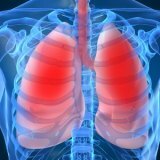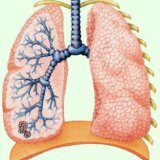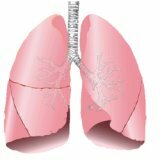Pulmonary failure: what is it, symptoms, treatment
Content
- What is pulmonary failure?
- Causes of pulmonary failure
- Respiratory Failure Symptoms
- Diagnostics
- Pulmonary insufficiency treatment
- Prevention and recommendations
What is pulmonary failure?
Pulmonary failure (respiratory or respiratory failure) is a condition in which the respiratory system cannot guarantee gas exchange and therefore maintain an adequate level of oxygen and / or carbon dioxide in blood.
When the oxygen concentration is low, doctors talk about hypoxic respiratory failure (type I or partial).
On the other hand, when blood carbon dioxide levels are high, doctors talk about hypercapnic respiratory failure (type II or general).
In this case, especially in severe and rapidly developing forms, excess carbon dioxide makes the blood acidic (that is, the pH of the arterial blood drops below 7.30).
In the first stage, the kidneys try to neutralize this excess acidity by circulating bicarbonates (bicarbonates). When this compensatory mechanism also becomes insufficient, respiratory acidosis, a condition that is a medical emergency.
Pulmonary insufficiency type I is the most common form and can be found in almost all pathological conditions associated with the lungs. Some of the more common are pulmonary edema or pneumonia. Pulmonary insufficiency type II can be found, for example, in severe forms chronic obstructive pulmonary disease and asthma.
Doctors also divide this condition into an acute form of respiratory failure (that is, rapid and sudden onset) and chronic pulmonary failure (which lasts for several months or years). The latter can precipitate due to an intercurrent event (eg, respiratory tract infection) and become acute (exacerbations, acute chronic pulmonary insufficiency).
Forms of chronic respiratory failure can be characterized by an increase in circulating red blood cells (red blood cells), a compensation system that the body enters in an attempt to transport as much oxygen as possible.
Patients with chronic pulmonary disease often also have a heart condition known as chronic cor pulmonale, which characterized by a change in the structure and functions of the right heart (the right ventricle has thickened and / or expanded walls), which, are found to pump blood in the pulmonary circulation, which, due to changes in the architecture of the lungs, represents high blood pressure (pulmonary hypertension).
Read also:Asthma: Causes, Signs and Symptoms in Adults, Treatment
Causes of pulmonary failure
Respiratory failure can result from changes in one of the various components that are responsible for the functioning of the respiratory system:
- airways and pulmonary alveoli;
- chest and respiratory muscles;
- respiratory centers at the level of the brain;
- peripheral nervous system.
For the correct exchange of respiratory gases, it is also necessary that the heart functions properly and that there is sufficient the number of circulating red blood cells (and more specifically hemoglobin, a protein in red blood cells responsible for transporting oxygen in blood).
There are several diseases and conditions that can damage the body and cause lung failure:
- central nervous system diseases: tumor, stroke or a cerebral hemorrhage affecting the brain stem, as well as drug overdose, can harm the respiratory centers and cause respiratory failure;
- spine changes (for example, severe kyphoscoliosis) and chest (for example, compression after injury) or severe obesity can impair ventilation;
- changes in the respiratory muscles and peripheral nervous system: they can impair the ability to ventilate (this can happen in the case of muscular dystrophy, myasthenia gravis, Guillain-Barré syndrome, amyotrophic lateral sclerosis, poliomyelitis);
- airway changes: they can interfere with the correct passage of the air flow (for example, in the case of tumors of the larynx, edema of the glottis due to severe allergic reactions, asthmatic crisis);
- changes in pulmonary architecture and pulmonary alveoli: may interfere with the ability to exchange breathing gases (for example, chronic obstructive lung disease, pulmonary emphysema, pneumonia, cystic fibrosis, acute pulmonary edema).
Common causes of type I pulmonary insufficiency (hypoxemia) are:
- chronic obstructive pulmonary disease (COPD);
- pneumonia;
- acute pulmonary edema;
- asthma;
- massive pulmonary embolism;
- pulmonary fibrosis;
- obesity;
- kyphoscoliosis.
Common causes of type II pulmonary insufficiency (hypercapnika) are:
- chronic obstructive pulmonary disease (COPD);
- asthma;
- myasthenia gravis;
- poisoning / overdose of narcotic drugs or medications (for example, barbiturates) with depression of the respiratory centers;
- tetanus;
- obesity;
- severe hypothyroidism (up to mixed hematoma);
- damage (head trauma, encephalitis, bleeding, tumors) of the brain.
Read also:Asthmatic status
Respiratory Failure Symptoms

The symptoms of lung failure vary depending on the underlying cause.
Common signs and symptoms for all conditions are:
- dyspnea and oxygen starvation;
- tachypnea (i.e. increased number of breaths:> 30 / min);
- paradoxical respiratory movements (the chest wall moves in the opposite way to the physiological one: the lungs or part of them are filled with air instead of emptying during exhalation and vice versa);
- the use of auxiliary respiratory muscles at rest;
- cyanosis (bluish discoloration of skin, lips, nails);
- tachycardia (accelerated heart rate) and arrhythmia;
- confusion, decreased response to stimuli (hyporeactivity), drowsiness to the point of lethargy, and loss of feeling when the presence of acute pulmonary insufficiency, that is, the rapid and sudden onset or worsening of a chronic condition, for example, due to infections.
Diagnostics
The diagnosis of respiratory failure is based both on the doctor's assessment and on instrumental studies and laboratory tests, which are prescribed by the doctor, based on the characteristics of the patient and the pathology due to which the pulmonary failure.
Depending on the case, the diagnostic pathway may include:
- Arterial blood gas analysis: an analysis that allows you to assess the concentration of gases (oxygen and carbon dioxide) in the blood, the degree of acidity of the same (pH), the level of circulating bicarbonates and their possible deficiency;
- Blood analysis: it is used to assess the number of red blood cells and the concentration of hemoglobin to assess the condition anemia or, conversely, polycythemia, that is, an excessive number of red blood cells circulating in the blood,
- as well as blood analysis to assess parameters of liver and kidney function, electrolyte levels (sodium, potassium, calcium, phosphates, magnesium), as well as to check for the presence coronary heart disease or muscle inflammation (myositis);
- Chest x-ray: allows you to evaluate some of the causes of respiratory failure (for example, pneumonia, pulmonary edema, pleural effusion, lung neoplasms, pneumothorax);
- Thyroid hormone analysis (in particular, TSH) to diagnose the presence of hypothyroidism;
- Computed tomography of the chest: allows you to evaluate changes in pulmonary architecture;
- Respiratory function tests (spirometry): allow you to distinguish between different causes of pulmonary insufficiency and to assess the severity of the disease;
- Electrocardiogram and echocardiogram: allows you to highlight or exclude the fact that acute respiratory heart failure reasons (e.g. heart attack, paroxysmal atrial fibrillation, other arrhythmias)
Read also:Aspergillosis
Pulmonary insufficiency treatment
Treatment for respiratory distress depends on the underlying condition. In general, the goal of therapy is to improve oxygenation and air exchange at the level of the pulmonary alveoli (called alveolar ventilation).
Depending on the case, therapy for pulmonary failure may include:
- Oxygen therapy: The first goal in the treatment of patients with respiratory failure is to correct the deficiency of blood oxygenation, which puts all organs and tissues of the body in a critical state. There are various ways of administering oxygen, which are selected depending on the condition of the patient.
- Usage auxiliary fans: the goal is to correct acidosis, that is, excessive acidity in the blood due to too high levels of carbon dioxide
In some cases, the doctor may consider it appropriate to administer other medications as well. The most common are diuretics, anticholinergics of ipratropium bromide, beta agonists, cortisone, antibiotics, and nitrates.
Prevention and recommendations
Pulmonary failure is a condition that has multiple causes (chronic obstructive lung disease (COPD), pneumonia, acute pulmonary edema, asthma, obesity, kyphoscoliosis, overdose of drugs or drugs that depress the respiratory centers, tetanus, severe hypothyroidism).
Therefore, the prevention of these diseases or conditions is an effective means of reducing the likelihood of developing pulmonary failure.
Especially important:
- no smoking;
- adopt a healthy lifestyle and diet;
- perform regular physical activity;
- get a tetanus vaccine;
- do not use drugs.



